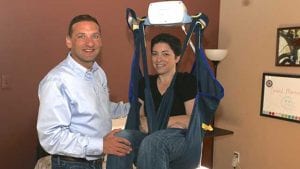Essex County Ceiling Lifts. Trying to decide if you need ceiling lifts system for your home? A ceiling lift is the best and most effective way to change the position of patients in hospitals or at homes. This way of moving people throughout a home or throughout a hospital has become a very common way for those with a disability issue. Some of the regular activities that people would like to get engaged in can be improved by the ceiling lifts.

Essex County Ceiling Lifts | Easy to use
A ceiling lift is very easy to use. It can help with moving an elderly or disabled person without putting any strain on the caregiver. A ceiling track lift is easier to use because it does not involve pushing or moving around through other obstacles such as cables, rugs or furniture. For those that have good upper body strength, a self-ceiling lift is super easy. It is also very beneficial to have a good means of communication available to the patient at all times in case of any unforeseen issue or problem. They usually come with an emergency stop and lowering cords. These can be lengthened for the person to be able to move themselves. The main benefit of a ceiling lift is that it will relieve the pressure and work from the other family members.
Essex County Ceiling Lifts | Better for the Patient
To this day it is alarming that hospitals and more home care services do not recognize the benefits of a ceiling lift. With a ceiling lift it alleviates and prevents injuries that come with manually lifting patients. These lifts would help with the productivity of the staff in a hospital or health care facility. It would help reduce the risk of developing pain and injuries as a result of movement. There are economical because they reduce the number of workers needed to move patients from one place to another. Ceiling lifts have higher access compared to a normal floor lift. They are more flexible. With the two types of ceiling lifts, a fixed motor or a portable motor, they would make a difference for your patient or family member. Fixed motors have a quick release and simple to service, where a portable motor is less costly, and they are smaller.
Essex County Ceiling Lifts | Space Saver
Since the ceiling lifts take no floor space, they are ideal for small rooms and small facilities. The track mechanism of a ceiling lift is secured with the highest standards to prevent any sudden movement. Many caregivers have used the ceiling lifts and stated that it has saved them time in the transferring of the patient. Manually moving patients are more physically demanding than a ceiling lift, making the transfer of patients faster and easier. Ceiling lifts are worth the money with all the benefits.
Searching for the best Essex County Ceiling Lifts? Back Home Safely is the place to call. We create safe home living environment for all families in New Jersey. Our main focus is to help people remain living in their own homes despite life’s challenges and any obstacles they may have. At Back Home Safely, we educate occupational therapists, case managers and social workers through presentations on home modifications. We are a member of Accessible Home Improvement of America, which is a national organization of independently owned and operated, certified providers and contractors. We are dedicated to providing Accessible Home Modifications, Independent Living Solutions and related products and services. Give us a call at (973) 219-4147 today and let’s make your home safe again. Safe & accessible homes start here!
Related Posts:
The Real Deal about Stair Lifts and How it Changes Lives
Passaic County Stairlift Supplier
Passaic County Wheelchair Ramp
Disabled Teenager Receives a Stair Lift as a Gift
How to Make Stairs Safe for Seniors and Those with Movement-Limiting Disabilities
Common Wheelchair Hazards in the Home
Integrating Wheelchair Ramps Aid in Promoting Independence Among Those with Limited Mobility
Platform Wheelchair Lifts Provide Optimal Maneuverability In and Around the Home
Frequently Answered Questions: Ramps and Wheelchairs
How to Make Stairs Safe for Seniors and Those with Movement-Limiting Disabilities
